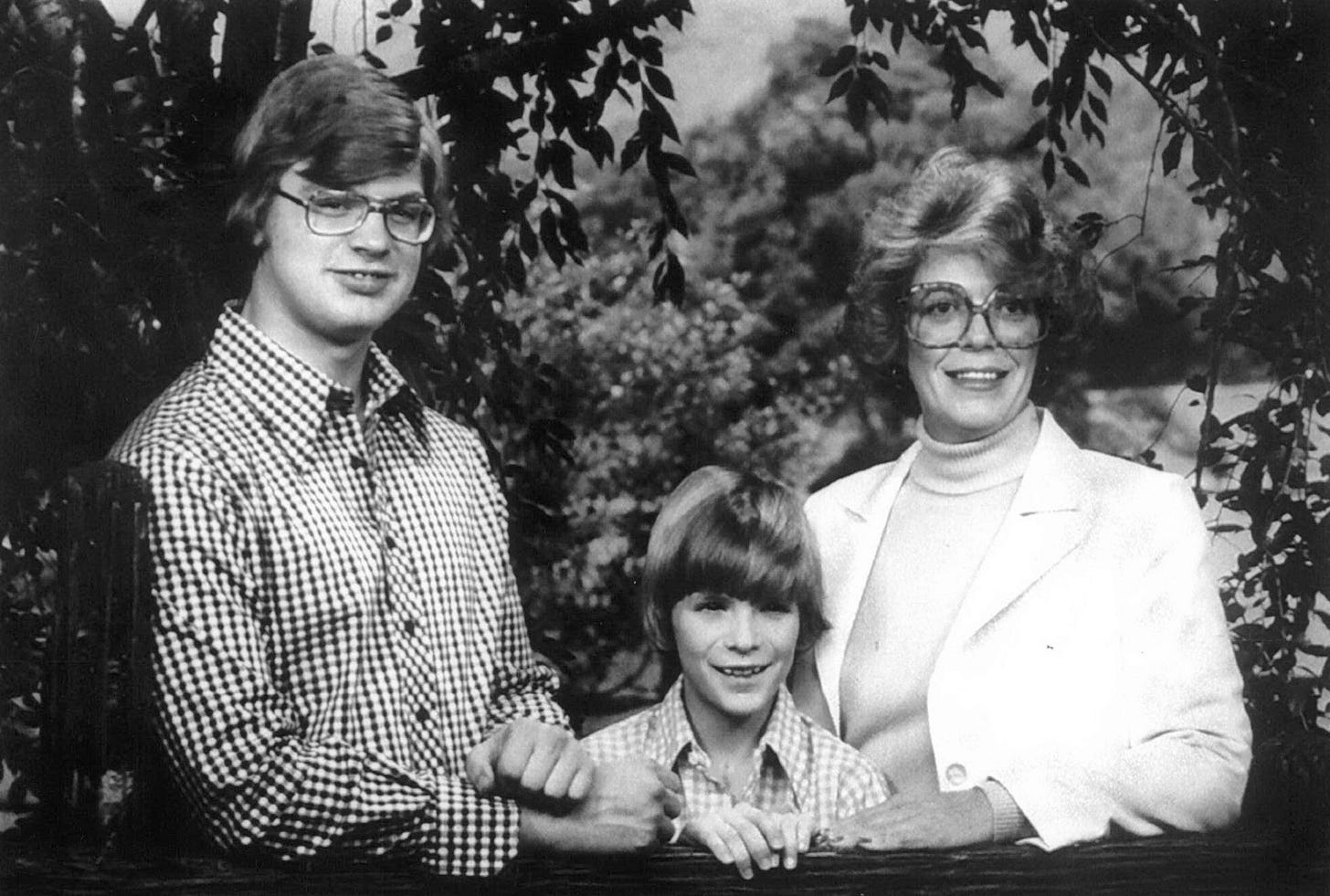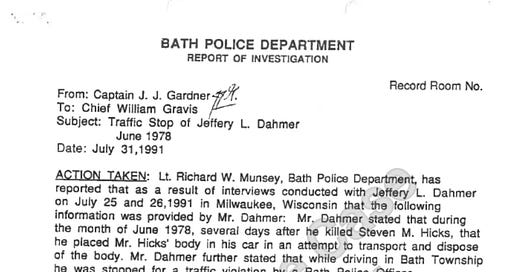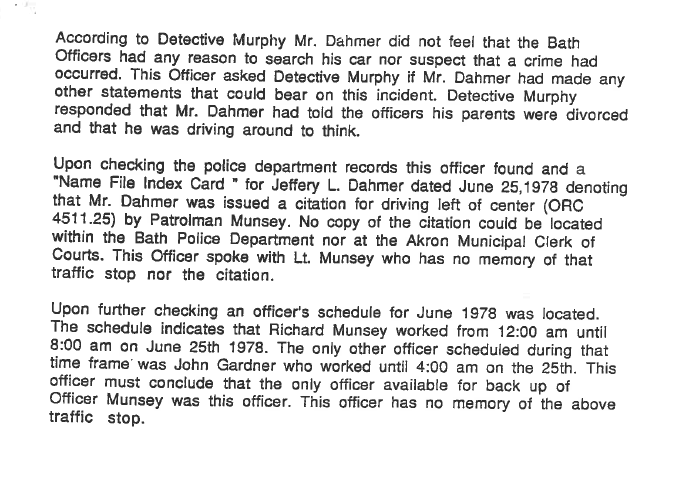Steven Hicks: New Evidence & Unanswered Questions / PART 2
Exclusive documents challenge the official Jeffrey Dahmer narrative.
Welcome back to our groundbreaking bonus series, where we continue our deep dive into the mysterious and unsettling case of Steven Mark Hicks. In Part 1, we explored the Missing Person/Homicide Investigation of Steven Hicks, dissecting key elements such as:
A father’s missing person report that raised red flags.
Conflicting physical descriptions provided by Steven’s own parents.
The official investigative timeline of Steven Hicks’ final hours.
The Bath Police Department’s investigation report.
And the critical question: What does the evidence really suggest?
The contradictions and inconsistencies we uncovered in official documents were staggering, raising serious questions about the case.
Now, in Part 2, we’re taking you even deeper. For the first time ever, we’re unveiling yet more never-before-publicized documents and providing exclusive access to primary sources that promise to shed new light on this foundational case. Prepare to explore additional files from the Steven Hicks investigation that raise even more unsettling questions and challenge the official narrative.
This is more than a story—it’s a pursuit of truth. Don’t miss these critical new findings. Your journey into the unknown starts here.
The Most Unbelievable Story in Criminal History
June 25, 1978 - 7 days after Steven Hicks vanished
Jeffrey Dahmer claims he was pulled over by Bath Township police while driving with three 30-gallon garbage bags containing dismembered human remains in his back seat. According to his confession, he was transporting Steven Hicks’ body parts to dispose of them in a gully when Officer Richard Munsey stopped him for ‘‘driving left of center.’’
The officer allegedly let him go without searching the vehicle.
This story, accepted by investigators and the public for decades, contains fatal flaws that expose the entire Steven Hicks narrative as potentially fabricated.
The Evidence That Doesn't Add Up
Investigative Report on Traffic Stop of Jeffrey L. Dahmer (July 31, 1991)
This report (shown below) details information gathered from interviews with Jeffrey Dahmer concerning the traffic stop on June 25, 1978, several days after he allegedly killed Steven Mark Hicks, and one week after Hicks was last seen.
The report also notes that it was two days since Hicks was killed, which would make the date June 23, 1978—yet another anomaly in the timeline.
Some further observations:
Dahmer’s Account: Dahmer stated that after killing Steven Hicks, he dismembered the body, placed the parts in three 30-gallon garbage bags, and put them in the back seat of his car several days later to dispose of them in a gully. While en route, he was stopped for a traffic violation in Bath Township by a Bath Police Officer.
Police Records Check: Captain J. J. Gardner’s investigation found a ‘‘Name File Index Card’’ for Jeffrey L. Dahmer dated June 25, 1978, indicating he was issued a citation for driving left of center (ORC 4511.25) by Patrolman Munsey. However, no copy of the citation could be located, and Lt. Munsey had no memory of the traffic stop or citation.
Officer Scheduling: The June 1978 schedule showed Richard Munsey worked from 12:00 a.m. to 8:00 a.m. on June 25, 1978. The report concluded that the only officer available for backup was John Gardner, who also had no memory of the stop.

The Traffic Stop That Never Made Sense
This case highlights critical gaps in police documentation and raises questions about how such a significant encounter could go unrecorded in official channels. Despite claims of carrying three 30-gallon bags of human remains in June heat, police records show only a minor citation with no officer recollection of the stop.
A summary of the investigation highlights significant red flags in this story:
Dahmer claims he was stopped while transporting body parts in garbage bags.
Police records show a citation for ‘‘driving left of center.’’
No officer remembers the stop despite shining a flashlight on the horrific cargo allegedly in plain sight.
No citation copy exists - only an index card remains.
The Smell Factor
Dismembered human remains in June heat for ‘‘several days.’’
Three large, suspicious 30-gallon bags in a confined car space.
No officer could miss this overwhelming stench.
The Visual Evidence Should Have Triggered an Investigation
Large garbage bags in the back seat during a routine traffic stop.
Standard procedure requires vehicle inspection for safety violations.
No officer would ignore suspicious cargo during the citation process.
The Documentation Problem
Citation copies are mandatory for legal proceedings.
An index card alone is insufficient for legal citation.
Missing paperwork suggests administrative cover-up or fabrication.
The House of Cards Collapses
The Jeffrey Dahmer traffic stop story represents everything wrong with accepting confessions without verification. When examined critically, the story falls apart completely.
This isn’t just about one traffic stop. It’s about the entire foundation of the Steven Hicks case.
The evidence suggests this traffic stop, as described, and even testified to in the televised Court TV trial, never happened. And if it never happened, neither did the murder of Steven Hicks as we’ve been told.
The truth about what really occurred on that June day in 1978 remains hidden, but the lies are finally being exposed.
Ohio Prosecutor Letter to Joyce Flint’s Attorney
In the labyrinth of the Jeffrey Dahmer investigation, every document tells a story. One such document (shown below), a letter dated January 16, 1992, from Lynn C. Slaby, Prosecuting Attorney of Summit County, offers a rare glimpse into the behind-the-scenes dynamics of the case.
The letter is addressed to Mr. Richard C. Watters, Joyce Flint’s attorney in Fresno, California.

The Context: Cooperation and Conflict
The letter pertains to the ongoing Ohio criminal case of Jeffrey Dahmer and centers on the participation—or lack thereof—of Joyce Flint, also known as Rocky Flint (likely as a witness or party involved in the case), in the ongoing investigation.
At the time, Joyce was residing in California, far from the epicenter of the case in Ohio. The prosecutor’s office had been relying on her cooperation to corroborate information provided by her son, Jeffrey Dahmer, and to assist in piecing together the events surrounding his alleged crimes.
Until January 6, 1992, Joyce’s cooperation had been described as “excellent.” However, a sudden shift occurred when her attorney, Mr. Watters, advised her against participating in a scheduled interview with the prosecution to corroborate the information her son had provided to the investigators.
This refusal marked a turning point in the relationship between the prosecutor’s office and Joyce Flint, raising questions about what might have prompted this change.
The prosecutor’s office appears to be seeking to maintain direct communication and cooperation with Ms. Flint and other members of the Dahmer family for the ongoing investigation.
Key Points from the Letter
Acknowledgment of Prior Cooperation
The letter commends Joyce Flint for her previous willingness to assist, noting that her cooperation had been “excellent” up until the recent breakdown in communication. This acknowledgment underscores the importance of her role in the investigation and the prosecution’s reliance on her input.Attorney’s Advice Against Participation
The letter highlights a disagreement between the prosecutor’s office and Mr. Watters, who had advised Joyce not to participate in the scheduled interview. The prosecutor requested written confirmation of this advice, which Mr. Watters eventually provided. This document was then added to Joyce’s file, formalizing the attorney’s stance.The Role of Investigators
During prior communications, investigators had shared information with Joyce Flint about the status of her son’s criminal case and the ongoing investigation. This collaborative approach was also extended to other members of the Dahmer family, emphasizing the prosecution’s efforts to maintain open lines of communication.Request for Direct Contact
The letter concludes with a request for Mr. Watters to provide a copy of his letter to Joyce Flint, so the prosecution would not have to attempt direct contact with her. This highlights the delicate balance between respecting legal boundaries and ensuring the investigation could proceed without unnecessary delays.
The Timing of the Breakdown
The sudden shift in Joyce Flint’s cooperation raises several intriguing questions:
What Happened on January 6, 1992?
Was this change driven by media scrutiny, legal strategy, or personal reasons? The timing suggests that external pressures or evolving family dynamics may have played a significant role.Impact on the Prosecution’s Case
How did this communication breakdown affect the prosecution’s ability to build its case? Joyce’s insights and corroboration would have been critical in verifying details of her son’s inconsistent confessions and impossible timelines.
What specific information did the prosecution hope to gain from Joyce Flint?
Media and Public Pressure
By early 1992, the Dahmer case had become a media sensation. Did the intense public scrutiny also influence Joyce’s decision to withdraw from active participation?
Crucially, Jeffrey Dahmer’s account of events is riddled with red flags. The timing of the alleged Steven Hicks murder suggests that either scenario Dahmer provided would be impossible. In June 1978, Joyce was still living at the family property with her two sons, making Dahmer’s claim of being “alone at home” implausible. Alternatively, his other timeline of the fall of 1978 places him at Ohio State University, far from the family home.
Was Joyce’s attorney advising against her participation to avoid the risk of self-implication in the Steven Hicks murder case? If the murder occurred in June 1978, as claimed, Joyce could have been implicated, potentially accused of complicity or a cover-up, or both… Is this why Dahmer attempted to shift the timeline to the fall of 1978, a period after Joyce had left the family home, in an effort to protect his mother?
And remember—there’s another layer to this story. The 1992 $10 million civil wrongful death lawsuit made against the Dahmer family points to a vehicular homicide, not a murder. This raises even more questions about the true nature of Steven Hicks’ death and whether the official narrative aligns with the evidence.
For Joyce Flint, the mother of a man whose alleged crimes shocked the world, the decision to cooperate—or not—was undoubtedly fraught with personal and legal considerations. For the prosecution, her involvement represented a vital piece of the puzzle in their pursuit of justice.

The Bottom Line: The Truth Demands Justice
As we close Part 2 of our latest investigation into the Steven Hicks case, we’re left with more questions than answers—and that’s exactly where we need to be. The evidence we’ve uncovered doesn’t just challenge Jeffrey Dahmer’s confession; it exposes fundamental flaws in how this foundational case was investigated, prosecuted, and ultimately accepted as truth.
Joyce Flint’s sudden silence on January 6, 1992, wasn’t a mother protecting her son—it was a woman whose attorney recognized the legal quicksand beneath her feet.
When timeline impossibilities make Dahmer’s confession implausible, when a $10 million wrongful death lawsuit points towards a vehicular homicide instead of murder, and when crucial evidence suggests a cover-up rather than a serial killing, we must ask ourselves: What story are we really being told?
The Steven Hicks case isn’t just about Jeffrey Dahmer—it’s about our collective responsibility to demand truth over convenience, evidence over narrative, and justice over closure. If Steven Hicks died in a tragic accident that was subsequently covered up, his family deserves to know. If our understanding of one of America’s most notorious serial killers is built on a foundation of lies, the public deserves the truth.
This investigation has revealed that even the most ‘‘solved’’ cases can harbor secrets that reshape everything we thought we knew. The letter from Prosecutor Lynn C. Slaby to Joyce Flint’s attorney isn’t just a piece of legal correspondence—it’s a window into the moment when those closest to the truth recognized how fragile their narrative really was.
The questions are mounting. The evidence is damning. The truth is within reach.
But uncovering it requires all of us—readers, researchers, and truth-seekers—to continue asking the uncomfortable questions and demanding the answers that official investigations failed to provide. Steven Hicks deserves justice, whatever form that truth may take.
Subscribe Now to Uncover the Truth
Don’t miss Part 3 of our groundbreaking series, where we’ll reveal more previously unpublished documents and damning revelations about the Steven Hicks case. The investigation continues, and the most shocking truths are yet to come.
What aspects of this case do you find most compelling? Share your thoughts in the comments below and join our community of truth-seekers demanding accountability in one of America’s most infamous criminal cases.







Joyce's attorney in Fresno, Watters, advised her to remain silent after January 6, 1992 - simply because she could provide truthful testimony. As I understand, on January 6, there were even several phone calls from the prosecutor in Ohio offering Joyce to testify in the Hicks murder case.
This is great!! At first, I was wondering if the traffic stop happened, but they made up the story about Hicks. Based on this evidence, it's pretty clear that traffic stop never happened. I'd bet on that. In the US, once a cop stops a vehicle, as long as the initial traffic stop was justified, they can arrest you for anything, even if it's unrelated to the initial stop. And I know the smell of a dead body. It's unlike any other smell in the world. There's no way a garbage bag would contain the stench!!